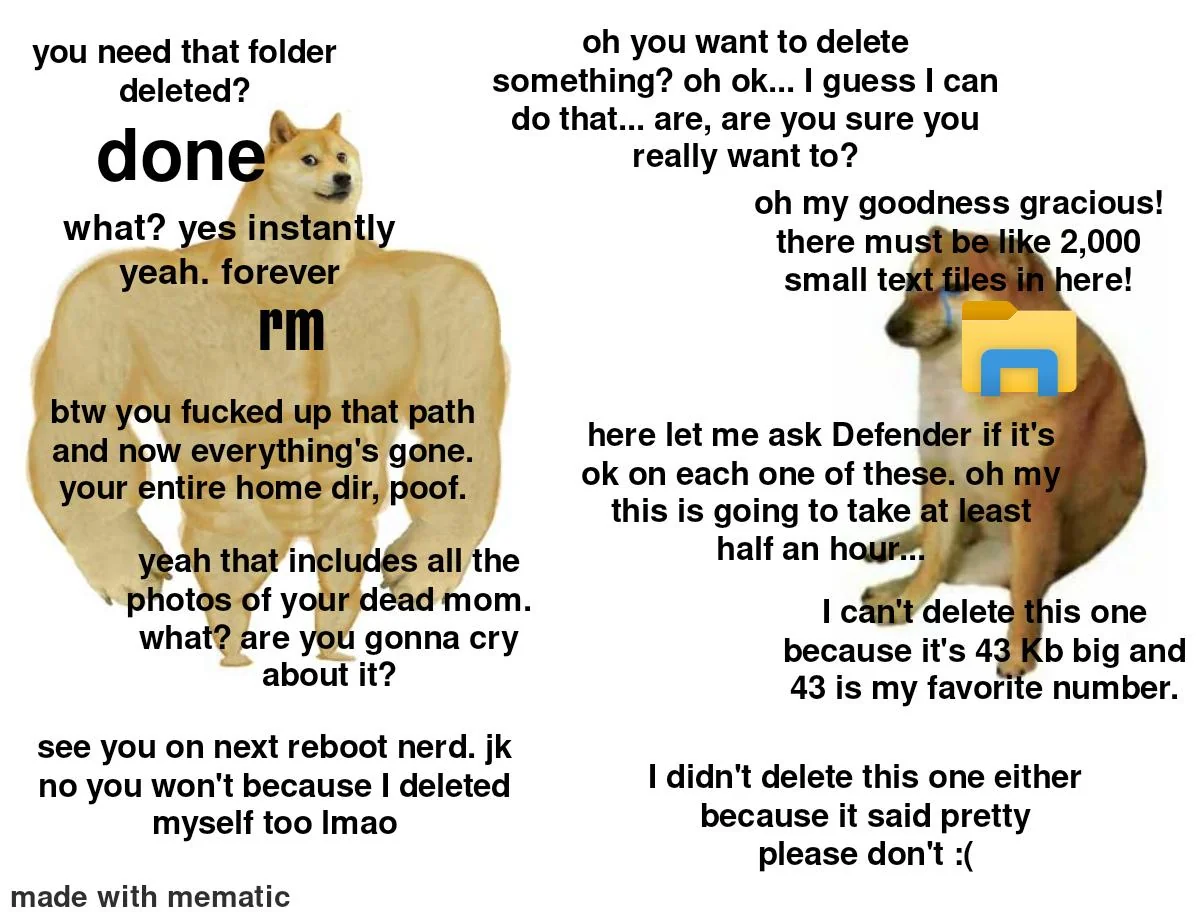this post was submitted on 22 Mar 2024
640 points (96.0% liked)
linuxmemes
21291 readers
1049 users here now
Hint: :q!
Sister communities:
- LemmyMemes: Memes
- LemmyShitpost: Anything and everything goes.
- RISA: Star Trek memes and shitposts
Community rules (click to expand)
1. Follow the site-wide rules
- Instance-wide TOS: https://legal.lemmy.world/tos/
- Lemmy code of conduct: https://join-lemmy.org/docs/code_of_conduct.html
2. Be civil
- Understand the difference between a joke and an insult.
- Do not harrass or attack members of the community for any reason.
- Leave remarks of "peasantry" to the PCMR community. If you dislike an OS/service/application, attack the thing you dislike, not the individuals who use it. Some people may not have a choice.
- Bigotry will not be tolerated.
- These rules are somewhat loosened when the subject is a public figure. Still, do not attack their person or incite harrassment.
3. Post Linux-related content
- Including Unix and BSD.
- Non-Linux content is acceptable as long as it makes a reference to Linux. For example, the poorly made mockery of
sudoin Windows. - No porn. Even if you watch it on a Linux machine.
4. No recent reposts
- Everybody uses Arch btw, can't quit Vim, and wants to interject for a moment. You can stop now.
Please report posts and comments that break these rules!
Important: never execute code or follow advice that you don't understand or can't verify, especially here. The word of the day is credibility. This is a meme community -- even the most helpful comments might just be shitposts that can damage your system. Be aware, be smart, don't fork-bomb your computer.
founded 1 year ago
MODERATORS
you are viewing a single comment's thread
view the rest of the comments
view the rest of the comments

the linux-file-deletion is used as a example for good software design. It has a very simple interface with little room for error while doing exactly what the caller intended.
In John Ousterhout's "software design philosophy" a chapter is called "define errors out of existence". In windows "delete" is defined as "the file is gone from the HDD". So it must wait for all processes to release that file. In Linux "unlink" is defined as "the file can't be accessed anymore". So the file is gone from the filesystem immediately and existing file-handles from other processes will life on.
The trade-off here is: "more errors for the caller of delete" vs "more errors due to filehandles to dead files". And as it turns out, the former creates issues for both developers and for users, while the later creates virtually no errors in practice.
Tell that to my dded porn collection.
Yes, the file itself (so the data and inode) is not gone as long as the handles live on. Only the reference is gone. You canstill recover the file. https://superuser.com/questions/283102/how-to-recover-deleted-file-if-it-is-still-opened-by-some-process#600743
No, no. Exactly what the user told it to do. Not what they intended. There's a difference.
Machines will always do what you tell them to do, as long as you do what they say.
What do they say?
Exactly type
rm -rf /instead ofrm -rf ./and you ducked up. Well you messed up a long time ago by having privileges to delete everything, but then again, you are human, some mistakes will be made.Don't modern versions of rm block calling on / unless you pass a separate flag?
Yup I think it's --preserve-root
Deleting the current directory via
./seems contrived since you would just use.or more likely the directory name from outside the directory. What does happen isrm -rf ${FOO}/while${FOO}is an empty string.Not sure if you're referencing the Steam incident, but Steam did exactly that: https://www.theregister.com/2015/01/17/scary_code_of_the_week_steam_cleans_linux_pcs/
yup, did that one on a server at work. had to go cap in hand to my manager to get him to fix it
Even so,
.and/are right next to each other so it's a likely typo. You might press enter before you catch it.${Insert meme of qwertz ganz not having that problem here}
The double check before you rm things 🤷.